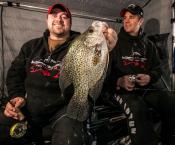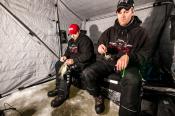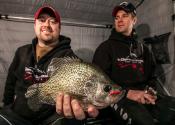 Last week in South Dakota saw some of the fastest perch and crappie action I’ve ever been witness to when filming. Many have probably already caught the show – http://www.youtube.com/watch?v=LsyXDPb96BQ – but in an effort to get the biggest fish and best footage, there’s a lot more that never made the cut. For this report, I’m going to focus on the shallow water crappie bite that went so well, and discuss some of the finer points that kept James and I getting bit throughout the day. We’ve been getting some questions on everything from jigging technique to lure selection, and while this bite was exceptional enough that you probably don’t need to go to such a level of detail, it’s good for when the bite gets tougher and you’re fighting for every fish you catch.
Last week in South Dakota saw some of the fastest perch and crappie action I’ve ever been witness to when filming. Many have probably already caught the show – http://www.youtube.com/watch?v=LsyXDPb96BQ – but in an effort to get the biggest fish and best footage, there’s a lot more that never made the cut. For this report, I’m going to focus on the shallow water crappie bite that went so well, and discuss some of the finer points that kept James and I getting bit throughout the day. We’ve been getting some questions on everything from jigging technique to lure selection, and while this bite was exceptional enough that you probably don’t need to go to such a level of detail, it’s good for when the bite gets tougher and you’re fighting for every fish you catch.
FISH IDIVIDUAL LOCATIONS AS A TEAM – First off, no matter what you decide to use, it’s best to compare notes and work together when trying to figure out a bite. The “where” in that equation is a key component. James and I started the morning split up, fishing slightly different locations. Even though we were nearby, we each were comparing activity levels in fish from both locations. After we determined both locations were holding active fish, we decided we might as well fish together to improve communication. Most days, it requires multiple moves and check-backs with LOTS of drilling, but shallow water fish can be sensitive to lots of noise. We kept that in mind while developing our bite that morning. While such planning doesn’t always include fishing together, it definitely involves a methodology for moving through baits.
 WHAT TO USE? – My strategy usually involves starting with bigger more aggressive baits, moving more subtle as I continue to change. My reasoning for this is based primarily on efficiency and the water I can cover while fishing aggressively. If fish will eat a quick, bait-less presentation, I’m all for it. For example, after the day-1 success with perch on Rippin’ Raps, I made sure to give it a go for these big crappies. Although I caught one, they simply didn’t seem as interested from what I could tell on sonar. I want multiple marks, reacting quickly, not dead-swimming in response to my bait. Then I moved to a rattle spoon, then a tumbler, all of which caught fish. However, a quick check with James confirmed that a pink/white pug-bug/white mustache worm was getting him bit nearly twice as often as myself, even though I was using live bait to tip my spoons. This is typically the point where most guys immediately switch to what their partner is using. That isn’t always a good idea, as we’re still developing the bite, and who’s to say that the bait style, jigging method, or any other number of variables isn’t contributing to James’ success? Instead I switched to a Glow Red Waxtail in 1/32oz., which is one of my favorites for crappies in testing from last winter. That way, we could eliminate either jig style or plastics type from the equation should I be shunned. Luckily, I was not, and the Waxtail became the new “standard” by which we compared baits throughout the rest of the day. Any good experiment needs a control, and James would continue catching fish until we got some more cloud-cover later in the morning; at which point it was his turn to start moving through the colors and bait types. By the end of the day, we found several bait and plastic types, mostly in the color red that delivered similarly. By going through this process, we gained the confidence needed to insure that we were fishing with the right presentation at the right time.
WHAT TO USE? – My strategy usually involves starting with bigger more aggressive baits, moving more subtle as I continue to change. My reasoning for this is based primarily on efficiency and the water I can cover while fishing aggressively. If fish will eat a quick, bait-less presentation, I’m all for it. For example, after the day-1 success with perch on Rippin’ Raps, I made sure to give it a go for these big crappies. Although I caught one, they simply didn’t seem as interested from what I could tell on sonar. I want multiple marks, reacting quickly, not dead-swimming in response to my bait. Then I moved to a rattle spoon, then a tumbler, all of which caught fish. However, a quick check with James confirmed that a pink/white pug-bug/white mustache worm was getting him bit nearly twice as often as myself, even though I was using live bait to tip my spoons. This is typically the point where most guys immediately switch to what their partner is using. That isn’t always a good idea, as we’re still developing the bite, and who’s to say that the bait style, jigging method, or any other number of variables isn’t contributing to James’ success? Instead I switched to a Glow Red Waxtail in 1/32oz., which is one of my favorites for crappies in testing from last winter. That way, we could eliminate either jig style or plastics type from the equation should I be shunned. Luckily, I was not, and the Waxtail became the new “standard” by which we compared baits throughout the rest of the day. Any good experiment needs a control, and James would continue catching fish until we got some more cloud-cover later in the morning; at which point it was his turn to start moving through the colors and bait types. By the end of the day, we found several bait and plastic types, mostly in the color red that delivered similarly. By going through this process, we gained the confidence needed to insure that we were fishing with the right presentation at the right time.
 JIGGING MOTION – There’s quite a bit written about lures, and unfortunately not always enough written about how to work those lures most effectively. I’m going to focus on the jig/plastic combinations that we used, as they brought the most success to the crappie bite I’m detailing. The Waxtail Jig operates like any other spike-tail, nail, or short tailed plastic in terms of the action. The bait needs to sit in the water horizontally to ensure the best action, so after each fish, it’s never a bad idea to check your knot and snug it so that the bait hangs horizontally. Now to impart that action, I was using a continuous, pounding-type jigging motion to keep the bait moving. I fished this bait with two modes, attraction, and bite detection. First, for attraction, I’d start off with some big rips or higher lifts until I saw fish on the screen. From there, I settled into a steady, rhythmic pound to ensure that tail was continually flickering. To check this, jig in the ice-hole, or even better view it with an underwater camera to see how fish respond. My goal was to keep that tail moving as long and as often as I could, jigging as aggressively as I could without spooking fish. These are tight lifts and drops, no more than ¼” or ½”, and continuous. As a fish would rise, especially the quick-risers, I went into bite detection mode, which typically involves what appears to be stationary. However, what I’m doing is slowly (very slowly) lifting to entice the bite (important) and detect it (more important that day). Jigging continuously is great and often triggers strikes, but you make it more difficult for these crappies than it needs to be when doing so. A slow lift keeps your rod tip steady and you can directly detect and hook more fish as a result.
JIGGING MOTION – There’s quite a bit written about lures, and unfortunately not always enough written about how to work those lures most effectively. I’m going to focus on the jig/plastic combinations that we used, as they brought the most success to the crappie bite I’m detailing. The Waxtail Jig operates like any other spike-tail, nail, or short tailed plastic in terms of the action. The bait needs to sit in the water horizontally to ensure the best action, so after each fish, it’s never a bad idea to check your knot and snug it so that the bait hangs horizontally. Now to impart that action, I was using a continuous, pounding-type jigging motion to keep the bait moving. I fished this bait with two modes, attraction, and bite detection. First, for attraction, I’d start off with some big rips or higher lifts until I saw fish on the screen. From there, I settled into a steady, rhythmic pound to ensure that tail was continually flickering. To check this, jig in the ice-hole, or even better view it with an underwater camera to see how fish respond. My goal was to keep that tail moving as long and as often as I could, jigging as aggressively as I could without spooking fish. These are tight lifts and drops, no more than ¼” or ½”, and continuous. As a fish would rise, especially the quick-risers, I went into bite detection mode, which typically involves what appears to be stationary. However, what I’m doing is slowly (very slowly) lifting to entice the bite (important) and detect it (more important that day). Jigging continuously is great and often triggers strikes, but you make it more difficult for these crappies than it needs to be when doing so. A slow lift keeps your rod tip steady and you can directly detect and hook more fish as a result.
 ROD SELECTION – I fished two different rods that day for two different reasons. The first was a 32” Tuned Up Customs Quick-Tip rigged with a fly-reel. In shallow water like we were fishing, I often prefer the fly-reel setup, and the Quick-Tip provides the perfect control for the baits we were fishing, along with the exceptionally fast tip which provides a ton of feel as well. This is important when you’re trying to precision-jig that Waxtail to get the most action from it, and for the most part, especially early in the day, the bites were so solid that detection was not an issue. Given the choice, I usually fish with a slightly stiffer rod provided I’m not missing bites. As the day went on, I switched to a custom rod I had the boys at Tuned-Up make me, which is somewhat of a Precision Noodle hybrid, or Precision Noodle Minus if you will. I love the bite detection ability of the Precision Noodle, but when fishing heavier baits I lose a bit of control, and when fishing outside, wind can make it difficult to see fish take the bait. By removing an inch and a half or so, I was able to have them build the perfect rod that would prevent both of those instances when fishing larger jigs. With the bite slowing down, if only slightly, that noodle tip was required to see the really light biters or “up-hitters” I could now catch at will. Crappies can be notorious for light-bites, and I feel strongly that this new rod does a good job of both allowing control and seeing the bites. Of course, with lighter jigs, I’d be stepping to the original Precision Noodle to correctly match the weight of the bait I’m using.
ROD SELECTION – I fished two different rods that day for two different reasons. The first was a 32” Tuned Up Customs Quick-Tip rigged with a fly-reel. In shallow water like we were fishing, I often prefer the fly-reel setup, and the Quick-Tip provides the perfect control for the baits we were fishing, along with the exceptionally fast tip which provides a ton of feel as well. This is important when you’re trying to precision-jig that Waxtail to get the most action from it, and for the most part, especially early in the day, the bites were so solid that detection was not an issue. Given the choice, I usually fish with a slightly stiffer rod provided I’m not missing bites. As the day went on, I switched to a custom rod I had the boys at Tuned-Up make me, which is somewhat of a Precision Noodle hybrid, or Precision Noodle Minus if you will. I love the bite detection ability of the Precision Noodle, but when fishing heavier baits I lose a bit of control, and when fishing outside, wind can make it difficult to see fish take the bait. By removing an inch and a half or so, I was able to have them build the perfect rod that would prevent both of those instances when fishing larger jigs. With the bite slowing down, if only slightly, that noodle tip was required to see the really light biters or “up-hitters” I could now catch at will. Crappies can be notorious for light-bites, and I feel strongly that this new rod does a good job of both allowing control and seeing the bites. Of course, with lighter jigs, I’d be stepping to the original Precision Noodle to correctly match the weight of the bait I’m using.
So there you have it, some more detail from our South Dakota Crappie bite that hopefully translates into more fish on the ice for you this winter!
Joel
What size Otter were you fishing out of and what Marcum did you have ? Thanks
We’re fishing out of the XT1200 resort for the show, though we also spent some time for the perch portion in my XT1200 Lodge. I run an LX-7 most of the time.
Thanks!
Joel
I was more than a little envious of you guys while watching that show. Your tips in this report did a great job of filling any void pertaining to how to, gear, technique…etc.
I have had the good fortune to ice a few crappies in the 15″+ size range but never anywhere near the numbers you guys experienced.
Those huge perch were something else. I’ve never caught anything close to a few of the ones you pulled in on the show this past Sunday.
Just one more trip to add to the bucket list!
I have been taking advantage of the awesome crappie bite on what I’m 99.9% sure is the same body of water. Sure is fun consistantly catching slabs of that quality AND quantity! I have had some good success on the Trigger X nymph in assorted colors depending on the time of day and light conditions.
I noticed your 1200 had the bench seat. I have the swivel seats in mine and I slide out of them all the time. I sat in the bench one at the local gander mtn. And it felt wat better. Do you prefer the bench over the swivel seats?
I’m a bench guy, but mostly because it’s nicer for my kids and I to pile onto. For smaller persons in any number, you can fit a few more with the bench. That said, if it were just me and a fishing buddy, the bucket seats are pretty nice!
Joel
FANTASTIC After show fish report Joel !!! It was like a seminar at my laptop !!
I too was very envious of you two, watching you two catching the crappies was flipping awesome !!!
Not as envious as I was last year watching you pull that toad through a 5″ hole! Thanks for the comments Dave and looking forward to fishing again with ya soon!
Joel
fish there 12-18, had 12 crappie and 1 perch by noon. For those who seen Joel get his transducer in the line a lot have to remember. 5ft water, 1 1/2′ cone, you have to put your line right next to the transducer. It would go from green to orange or red in a split second. When hooked they swam in circles. I figured it out in the end to just horse them up in the shallow water. Lost 7 or 8 trying to wear them out. You do need a spring or light action pole. Fun time.
I just re-viewed the episode of the perch and crappies ..
You two make a great Team on the ice guys !!
Nice report Joel and another great show.
 Keep up the good work. By the way you and James must eat alot of fish. You both should be growing fins by now.
Keep up the good work. By the way you and James must eat alot of fish. You both should be growing fins by now. 
Joel,
i’ve said it before and I’ll say it again the attention to detail in your reports is simply fantastic. That kind of detail not only arms us with a few new tricks but can help shorten the learning curve on new baits and build confidence even for the most seasoned of ice heads. Keep up the awesome work my man!
MX – In response to the fish comment, I think if you’ll go back through the episodes (multiple seasons), you’ll see that we rarely if ever keep a full limit, and we typically release the larger ones as well. Not to mention, there’s plenty of bites were we don’t keep any fish at all, such as all of the crappies from this report.
I understand the implications and effects of harvest, but am not ashamed to harvest some fish, especially selectively when well-within daily, and more importantly, possession limits for even one single state that we fish.
We are also sensitive to fish populations and species that are especially vulnerable, such as large predators in lakes which have no protective slots or are already of low number or under high angling pressure. Large panfish also, almost always get a free pass because of their rarity, and we’ve spent a large amount of time in past shows to explain their conservation.
After being personally witness to more destroyed fisheries than I care to remember, I have a vast amount of respect for quality fish and quality fisheries. Not only in the habitat that it takes to create them, but the hard work it takes to maintain them. Having two kids of my own, the idea of preserving quality experiences is at the very top of my list, so please know that with every fish I put to the ice, I have an acuity and awareness of the implications of my actions.
That said, I appreciate the comment in that it’s never a bad idea to review your own ideals and be sure that you’re sticking to them.
Thanks,
Joel
Nice fish guys! Where the crappies relating to any cover or where they just roaming around in schools?
Anywhere we punched holes we had 6.5′ of water and no cover except for some sparse weeds right on the bottom. The fish were roaming around in schools and very sensitive to noise. If someone punched a hole near us or drove a wheeler past the house we wouldn’t get a fish for 10 minutes or so. Once things quieted down the fish would group back up and we had non-stop action.